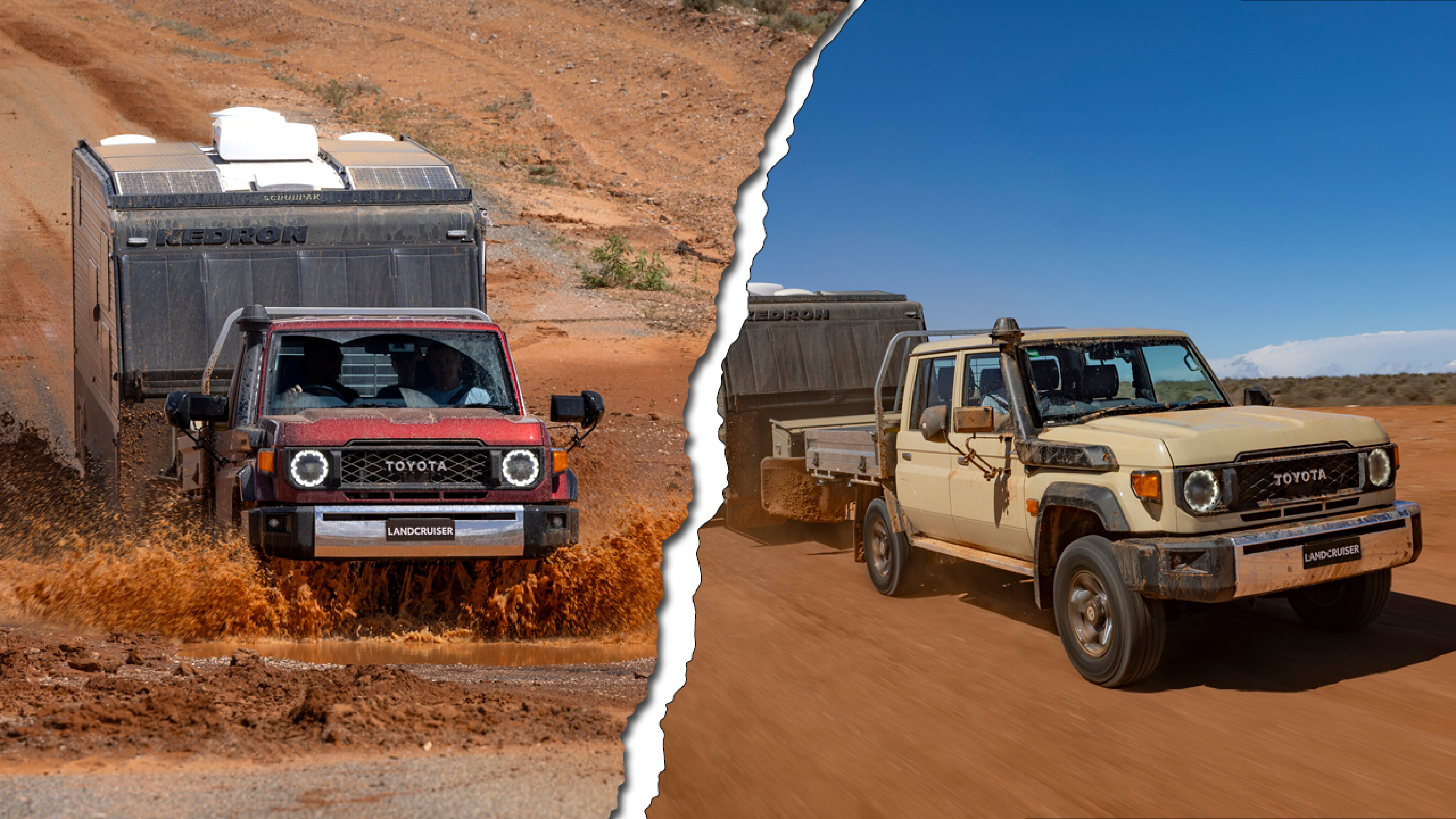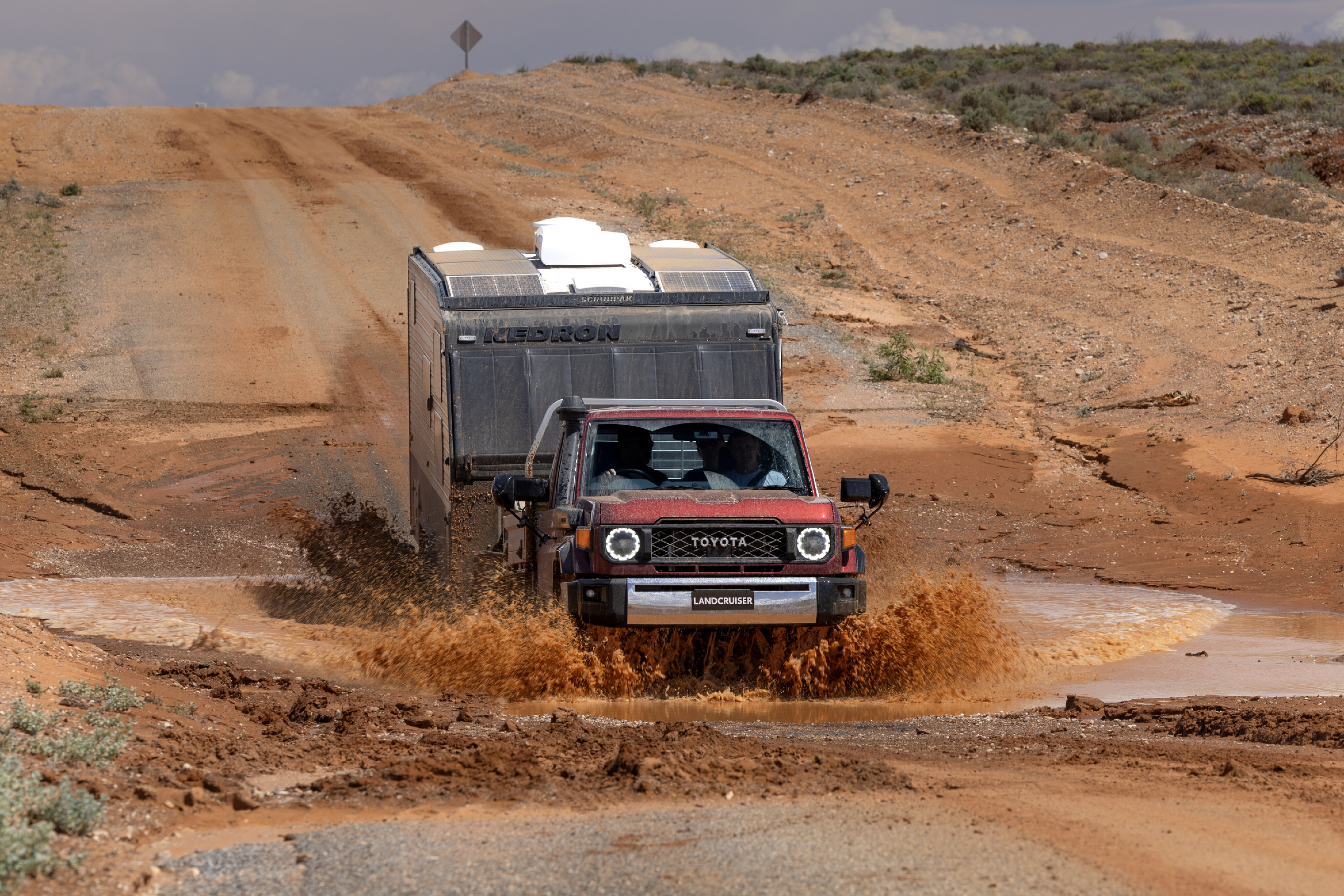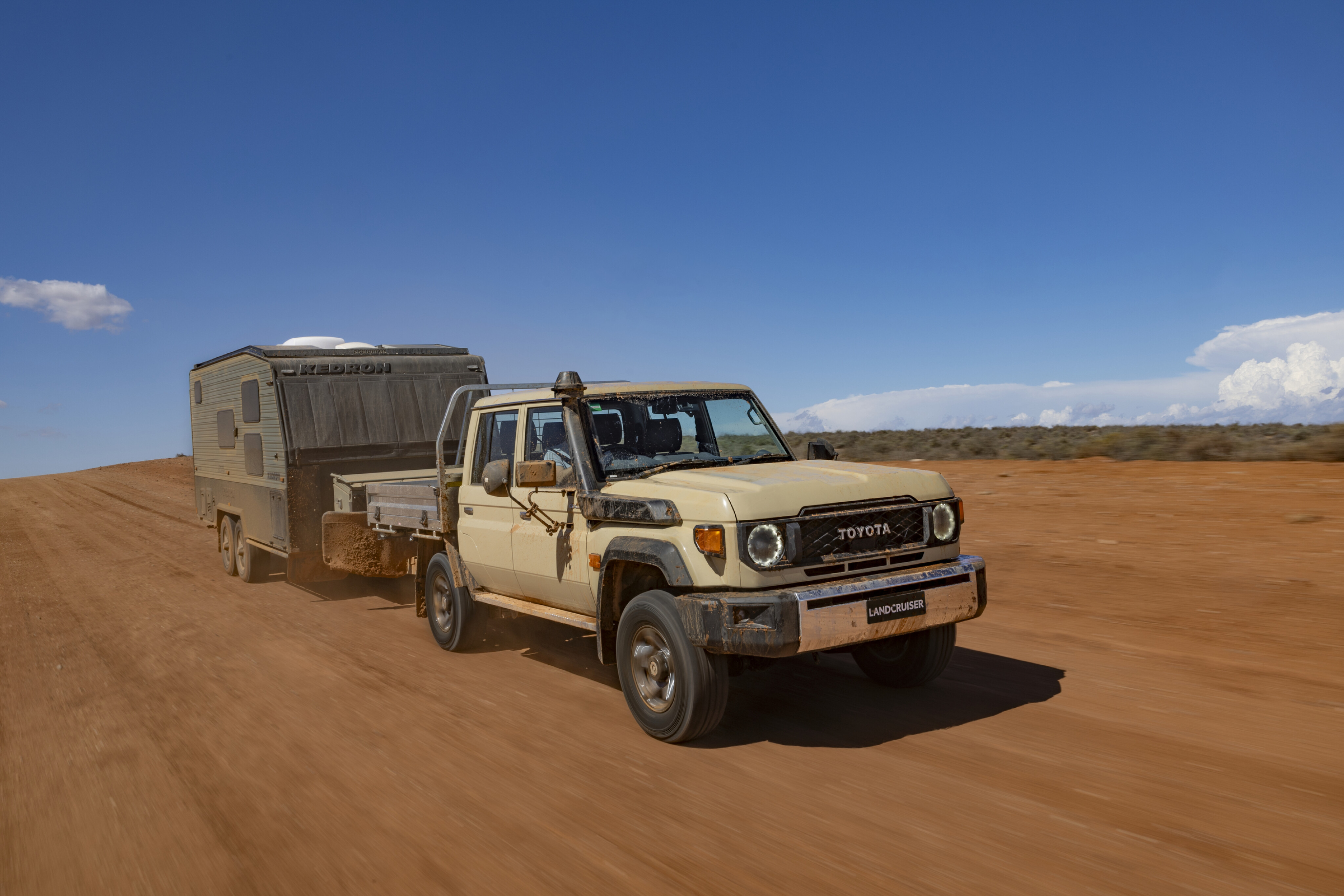
When Toyota launched its all-new 70 Series toward the end of 2023, the legendary off-roader landed with a 1GD 2.8-litre four-cylinder 150kW/500Nm turbo-diesel engine for the first time.
The inline-four joined Toyota’s venerable 1VD 4.5-litre V8 turbo-diesel, with many purists holding reservations about the I4’s towing ability. Following a test run in both vehicles towing a 3100kg Kedron off-road caravan, it’s safe to say those reservations are completely unwarranted.
Not only is the four-cylinder better on the open road, but the I4/auto combo is easier and more pleasant to drive around town, when towing and even off-road. Other than the soundtrack, it does everything better than the V8.
Towing specs
| 2024 LandCruiser 79 GXL double-cab | ||
|---|---|---|
| Engine | I4 turbo-diesel | V8 turbo-diesel |
| Transmission | 6-speed automatic | 5-speed manual |
| GCM | 7010kg | 7010kg |
| Towing capacity | 3500kg | 3500kg |
| Payload | 1325kg | 1270kg |
| Final drive ratio | 4.3:1 | 3.09:1 |
The four-cylinder engine feels lively compared to the V8. It’s more willing to get up and go, while the V8 likes to lope along and take its time to build speed when you put your foot down. The auto transmission not only has an extra ratio that benefits acceleration, but the final drive is a lower at 4.3:1 compared to the V8 model’s 3.09:1.
Nowhere is this performance difference more evident than when towing with the two powertrains. The drive loop included gravel and some sealed roads, and the four-cylinder/auto was far more spritely in its pick up when towing the van, while manually shifting the auto was easy when it came time to brush off speed for descents or when approaching washouts.

By comparison the V8 picked up speed more lazily when rowing through the gears but it cruised just as nicely once up to speed. But it was significantly slower than the four-cylinder vehicle when accelerating out of washouts – we first tried third gear but acceleration was lacking compared to the four-cylinder vehicle, and while using second gear created more noise from the engine, there was very little if any improvement in performance.
For many years we’ve heard buyers asking for an auto transmission for towing with a 70 Series and we have seen aftermarket auto conversions costing north of $20,000. Toyota has answered this call with the six-speed automatic transmission and potential buyers needn’t been concerned about the performance of the four-cylinder engine.

The Kedron van used on the towing loop was said to be putting around 290kg on the tow ball and again, the suspension was unfussed by this extra weight on the back of both the I4 and V8 Cruisers.
The inclusion of an automatic transmission will entice those who want to tow but convincing them that the four-cylinder engine is up to the job might be a hard task, while the auto will also appeal to fleet owners who need all-road ability but can’t trust their employees with a manual gearbox. The four-cylinder option also opens up the 70 to buyers not allowed to own or drive a V8-powered vehicle.
The four-cylinder will be a hard-sell to enthusiasts who don’t trust the smaller-capacity engine in a large heavy-duty 4x4, and they will continue to queue up to order a V8 model… if and when they eventually can. Any uncertainty as to the future of the V8 engine option will only promote the desire for that driveline further, and there’s no doubt they will remain in demand.
However, the automatic transmission make the 70 easier to drive, and the 1GD engine is more enthusiastic than the V8. Plus, with less weight over the front-end it feels a touch more nimble in the handling department. That lighter weight also adds around 55kg to the vehicle’s payload capacity.
Specs
| 2024 LandCruiser 79 GXL double-cab | ||
|---|---|---|
| Price | $83,500 | $87,600 |
| Engine | I4 turbo-diesel | V8 turbo-diesel |
| Capacity | 2755cc | 4461cc |
| Max power | 150kW@3000-3400rpm | 151kW@3400rpm |
| Max torque | 500Nm@1600-2800rpm | 430Nm @1200-3200rpm |
| Transmission | 6-speed automatic | 5-speed manual |
| 4x4 system | Part-time, dual range | Part-time, dual range |
| Crawl ratio | 38.51:1 | 44.05:1 |
| Construction | 4-door ute body on ladder frame chassis | 4-door ute body on a ladder frame chassis |
| Front suspension | Live axle with radius arms and coil springs | Live axle with radius arms and coil springs |
| Rear suspension | Live axle on leaf springs | Live axle on leaf springs |
| Tyres | 265/70R16 on alloys | 265/70R16 on alloys |
| Kerb weight | 2185kg | 2240kg |
| GVM | 3510kg | 3510kg |
| GCM | 7010kg | 7010kg |
| Towing capacity | 3500kg | 3500kg |
| Payload | 1325kg | 1270kg |
| Seats | 5 | 5 |
| Fuel tank | 130L | 130L |
| ADR fuel consumption | 9.6L/100km combined | 10.7L/100km combined |
| On test fuel consumption | N/A | N/A |
| Approach angle | 33° | 33° |
| Ramp-over angle | N/A | N/A |
| Departure angle | 27° | 27° |
| Ground clearance | 302mm | 302mm |
| Wading depth | N/A | N/A |



COMMENTS